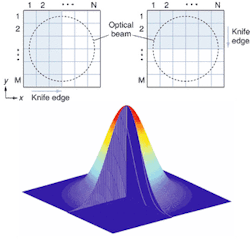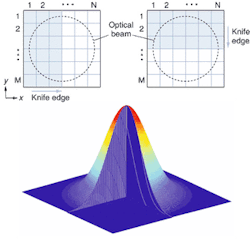All-digital profiler handles high-power beams
Many laser-based applications require precise and repeatable laser-beam profiling, particularly at high power levels. These applications include manufacturing, semiconductor materials processing, surgery, nondestructive testing, and three dimensional (3-D) object reconstruction, to name just a few. High-power laser beam profiling is typically done by moving a knife edge or pinhole through the beam and monitoring the resulting change in beam power. This method requires accurate analog-mode translation of a mechanically moved element. Problems can include limitations in terms of speed, accuracy, and repeatability of measurement; moreover, the slow speed of the technique results in susceptibility to mechanical vibrations, forcing the instrument to be large and bulky. Photodetector-based profilers (such as those based on charge-coupled devices) cannot be used for direct profiling of high-power laser beams due to saturation effects, while attenuating optics can alter beam properties via thermal-lensing effects at higher powers.
Engineers at Nuonics (Orlando, FL) have developed an all-digital beam profiler that uses micromirror-device technology developed by Texas Instruments (Dallas, TX) in combination with high-dynamic-range photodetection optics to avoid problems related to high-power beams. In the device, the motion of the scanning elements, the beam-aperture-scan operation, and all control electronics for the mechanical scan are digital.
Nuonics had previously developed all-digital fiberoptic variable attenuation generated by selectively controlling an array of digital micromirrors illuminated by an optical beam of known spatial beam profile.1 The company's engineers applied the principle in reverse, selectively controlling the array of digital micromirrors—simulating a moving mechanical element such as a knife edge—and measuring optical power, thus determining the unknown spatial profile of an illuminating laser beam.
The profiler operates from the visible through the infrared (IR), handling continuous-wave and pulsed beams up to 10.5 mm in diameter and with optical powers to 5 kW/cm2. Measuring over a 65-dB dynamic range, it calculates all standard beam parameters, displaying two- and three-dimensional plots.
The device contains a two-dimensional (2-D) small-tilt micromirror device, a large-area photodetector with processing electronics, and a beam block, and is hooked up to a computer. Each micromirror element has two states of operation, the +θ and -θ positions, with θ approximately 10°. When the desired micromirrors are set to +θ, the relevant portion of the optical beam is reflected to the photodetector and a power reading is taken. With the other micromirrors set to -θ, the rest of the beam is directed to the beam block. The arrangement imitates a 2-D photodetector array scanned with a knife edge or other shaped apertur.
Initial profiler results in the visible band using a visible micromirror device have shown promising results.2 Operation in the IR has also been achieved, with resolution limited to 13.8 µm by the pixel pitch of the micromirror device. In one example, programming micromirrors to flip in succession simulates a moving knife edge (see figure). Operation is expected to be reliable; the Texas Instrument micromirror devices are at the heart of more than one million projection-display systems.
REFERENCES
- US Patent No. 6,222,954, 2001.
- Applied Optics 41(18) (June 20, 2002).

